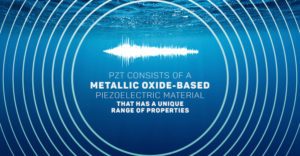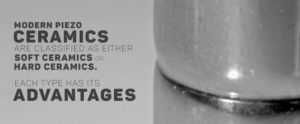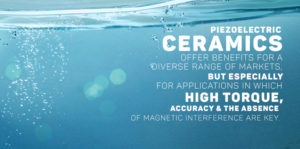Transmitting Acoustic Signals Through Water: Echo Sounding
There are many industries that need to “see” underwater. For example, companies that rely on sea transportation need to know how deep water is to ensure a ship does not run aground. Fishing operations need to find fish, and researchers hunt for shipwrecks.
Not only do they need to have reliable data for what is underwater, they also need accurate information on ports. Although there are many charts for major ports around the globe, for some regions, an up-to-date chart may not exist. For a ship in the middle of the ocean, the charts are not as reliable.
Echo sounding is the solution to these challenges. Echo-sounding technology enables research vessels and others to measure distances underwater by using sound. A form of sonar (SOund Navigation And Ranging), echo sounders can be stand-alone devices or attached to a ship.
Read on to learn more about how echo sounding works, including how it relies on piezoelectricity. You will also learn how it developed into the technology we know today, and how industries today are taking advantage of piezoelectricity.
How Does Echo Sounding Work?
Echo sounders transmit a pulse of energy directly downwards from the bottom of the ship. The pulsation moves through the water and pings off the floor of the sea. It then travels upward until the echo sounder receives the echo.
Once it receives the returned ping, the echo sounder measures how long the pulse took to travel from the seabed and back up to the vessel. Using this data, it can precisely calculate the depth of the water.
The Piezoelectricity Effect and Ultrasonic Sonar
Piezoelectricity is the electric charge that some solid materials can accumulate when mechanical stress is applied to them. Echo sounding is just one of the many commercial and industrial technologies that relies on piezoelectricity.
Jacques Curie and his younger brother Pierre discovered piezoelectricity in 1880 while conducting research into how pressure creates electrical charge in crystals. As they studied tourmaline, quartz, topaz, cane sugar and Rochelle salt (Potassium sodium tartrate), the men found that Rochelle salt produces an electrical charge when stressed.
This discovery facilitated the development of the gramophone (an earlier version of the phonograph) and stress measuring devices. Subsequently, researchers determined that piezo would change dimension or create a force upon receiving an electrical charge. The piezo became the primary force behind the operating principle for ultrasonic transducers.
In 1917, Paul Langevin, along with a team of researchers, developed the first commercial application to take advantage of the piezoelectric property of quartz. They invented an ultrasonic sending and receiving system — the forerunner of modern-day sonar — that solved the problem of transmitting acoustic signals in water.
Sonar in Its Earliest Form
The original sonar device consisted of a hulking gadget that looked like an oversized breadbox. It had a large transducer manufactured from quartz crystal — the resonator for the ultrasound devices — fastened between two steel plates, as well as a hydrophone designed to detect the return echo of submarines.
The device set the quartz piezoelectric crystal into oscillation by sending an electrical signal. The high-frequency mechanical vibration was transmitted through water to a reflecting body, and then to a second quartz crystal, which received the reflected high-vibratory energy or “ultrasound.”
Based on the time lapse between sending the signal and receiving the echo, the crew could calculate the distance from the source to the reflecting body. The top-secret sending and receiving system was initially named an “ultrasonic submarine detector.” Both the British and U.S. governments took advantage of this technology toward the end of World War I. The British Royal Navy used the information to calculate the distance of German submarines and place the depth charges more accurately.
The development of the sonar was instrumental in raising the level of awareness to the potential of piezoelectricity devices in other industries and applications.
PZT: Improving Sonar Technology
During World War II, independent research groups operating in the United States, Japan and Russia began to concentrate their research and development (R&D) efforts on ferroelectric materials. Researchers found that certain polycrystalline non-metallic materials — ceramics — had inherent mechanical strength.
Through a sintering process, researchers combined specific metallic oxide powders and found that the resulting ceramic material demonstrated unusually high dielectric constants compared to natural piezoelectric materials. Although many industrial and commercial applications use polymers and single crystals, the majority of modern piezoelectric materials are made of polycrystalline ceramics. The most widely used piezoelectric ceramic material in the world today is lead zirconate titanate, PZT for short.

Developed by scientists at the Tokyo Institute of Technology around 1952, PZT consists of a metallic oxide-based piezoelectric material that has a unique range of properties:
– It is stronger than some natural crystalline materials.
– Manufacturers can form PZT into nearly any shape and dimension.
– The material has greater sensitivity and a higher operating temperature than some other metallic oxide-based piezoelectric materials.
– Manufacturers choose PZT ceramics as their piezoelectric materials in sonar because they are durable, chemically inert and relatively inexpensive to manufacture.
The manufacturing process for creating PZT powders starts with very high purity oxide materials. The key ingredients in PZT are lead oxide, titanium dioxide, and zirconium dioxide. The process involves intimately mixing the starting ingredients, calcining or heating them to form the correct PZT compound, adding binders and spray drying to yield a free flowing powder ready for dry-pressing.
How Underwater Acoustic Transducers Differ Today
The transducer probe functions as the transmitter and receiver of the ultrasound machine by generating sound waves. The probe contains a sound-absorbing substance, which eliminates back reflections, and an acoustical lens which concentrates the sound waves.
Early transducer probes contained one or more quartz crystals (natural piezoelectric crystals). Applying an alternating electrical charge to the crystal changed its shape, and caused it to vibrate rapidly. The sound waves moved outward. Conversely, when sound waves hit the crystals, the pressure of the waveform generated measurable electric charges within the crystals. This phenomenon made it possible to both send and receive sound waves.
Modern piezoelectric high-frequency transducers generate ultrasonic signals, receive them or do both. The devices measure distance in air, water, or other fluids to determine flow rate and fluid level, among other things. Single ultrasonic transducers have the ability to generate and receive a signal, but most equipment separates the transmit and receive functions to enhance system and device performance.
Although some applications continue to use quartz and polymers as piezoelectric materials, PZT ceramics have become the preferred material choice because of its low electrical losses, high coupling coefficients, and low cost of manufacture.

Sonar Versus Echo Sounding
Sonar devices are capable of emitting sound waves horizontally to detect objects underwater. They measure or classify the echoes received from the objects. The earlier version of the sonar device had a maneuverable transducer, which the operator directed around the vessel like a large light to search for fish.
Modern sonar technology is capable of viewing 360 degrees in a horizontal plane, allowing operators to “see” ahead, behind and/or around a vessel.
An echo sounder, on the other hand, is generally limited to vertically emitting short pulses directly below the vessel. The waves bounce off the target object and echo back to the receiver. There must be a minimum distance between the transducer and the object. In addition, the vibrations caused by the transmission must dissipate before the transducer can receive the echo properly. There are many types of echo sounders, including:
– Single-Beam Echo Sounders — A single-beam echo sounder uses one emitting and receiving transducer. The device releases a series of energy pulses or sound waves that fill a small area underneath the vessel with sound. It can measure the depth of a particular area, but it does not supply the details of the sea-bed and the relevance of the various sea floor measurements to each other.
– Echo Sounder Sweep Systems — Often used for shallow bodies of water, the sweep system uses many single-beam echo sounders that are equally spaced along a boom, multiple booms, of a vessel. The sweep system provides complete coverage of the seabed at certain depths, while simultaneously acquiring the exact depth and position of each measured sounding.
– Multi-beam Echo Sounders —Multi-beam echo sounders have become the accepted technology used to survey the ocean floor. Unlike the single-beam echo sounder, the multiple-beam system can plot dozens or even hundreds of points in a line perpendicular to the heading of the vessel.
The multi-beam echo sounder offers the advantage of mapping large areas of the ocean floor from the ship. The system is also more cost-efficient because the array of echo sounder transducers and signal processing electronics moves the echo-sounder beam across the ocean bed, covering a large area with each sweep.

How Manufacturers Use PZT Today
Today, manufacturers use base PZT formulations to create advanced piezoelectric materials. They modify PZT by combining it with different dopant materials to produce a variety of compositions, which they can configure for different applications.
Modern piezoceramics are classified as either soft ceramics or hard ceramics. Each type has its advantages:
– Soft ceramics — The advantages of soft ceramics include high dielectric constant, high coupling and high charge sensitivity. The soft ferroelectric behavior of the material also makes it easy to polarize. Soft ceramics are ideal for flow sensors, level sensors and ultrasonic nondestructive testing/evaluation (NDT/NDE) applications. The material is also suitable for aerospace products and accurate inspections of automotive structures.
– Hard ceramics — Hard PZT (or “high power” ceramic powders) can withstand high electrical and mechanical stresses and pressures. Under these conditions, it experiences minimal changes, which makes hard ceramics ideal for high power applications. The material also has very good stability under high mechanical loads and operating fields. The best uses for hard ceramic include the generation of ultrasonic or high-voltage energy in ultrasonic cleaners, sonar devices and other devices.
As a leading supplier and manufacturer of piezoelectric ceramics and devices, APC International, Ltd. (APC) has specially formulated PZT blends made of the highest purity raw materials. For low-power resonance or non-resonance devices, and when specifications call for high coupling and/or high charge sensitivity, we have APC 850 or APC 855 for soft ceramic applications.
We suggest APC 840 and APC 880 materials for ultrasonic, sonar, or high-voltage requirements in ultrasonic cleaners, sonar and other devices. APC 880 offers many benefits, including a high piezoelectric charge constant (d33) — compared to the reference values for this composition — and a greater power output per volume of material.

Other Industries That Benefit From Piezoelectric Ceramics
The commercial sonar industry continues to use piezoelectric materials, especially PZT. The piezoelectric ceramic industry has experienced a surge in popularity as commercial and industrial companies across virtually every sector of the global economy are realizing the many possibilities of piezoelectric devices.
Piezoelectric ceramics offer benefits for a diverse range of markets, but especially for applications in which high torque, accuracy and the absence of magnetic interference are key. The many industries taking advantage of piezoelectric ceramics today include:
– Industrial — Most industrial processes rely on piezoelectric motors, sensors, actuators and other devices. For example, APC makes actuators that provide precise control of industrial machining tools. Transducers enable individual part cleaning and plastic welding, as well as drilling and milling of ceramics and other difficult materials.
– Automotive — Piezoelectric sensor technology has helped propel significant safety advances in the automotive industry, including seatbelt locks, knock sensors, airbag sensors and more.
– Aerospace — Aerospace requires piezoelectric mechanical devices that are small and very accurate. They must be highly efficient and have a higher power-to-weight ratio than electromagnetic motors.
– Medical — Ultrasound and other medical imaging technology depend on piezoelectric technology. Sophisticated dental and surgical tools, which demand accuracy and efficiency, also rely on piezoelectric ceramics.
– Electronic — From smart phones to acoustic guitars, piezoelectric components play an important part in day-to-day life.
– Security and defense — Piezoelectric motor components are essential for the defense industry, which requires silent operation, accuracy in positioning and zero magnetic interference in sonar, guidance and tracking systems. Piezo transducers are a vital component for domestic security systems.
– Power generation and flow monitoring — Piezoelectric components make it possible to monitor energy or fuel consumption, flow rates and other important metrics.

Contact American Piezo
As a leading supplier and distributor of piezoelectric materials and devices, APC works closely with our customers to meet their requirements each step, from conception to production. Our goal is to provide products and manufacturing capabilities that add value to your business.
We also have the manufacturing expertise to meet your custom specifications for piezoelectric ceramics and devices. Using soft and hard-body lead-zirconate-titanate (PZT) materials, we offer precision manufacturing for piezoelectric transducer components, plates, discs, rings, and custom shapes.
APC’s piezoelectric ceramics, powders and devices encompass an extensive range of uses including:
– Ultrasonic medical transducers/piezo ultrasound technologies
– Sonar and other defense-related products
– Ultrasonic cleaning components
– Ultrasonic welding components
– NDT components
– Flow-control products
– Level-control products
– Accelerometers
– Proximity Sensors
We also specialize in designing, machining, firing, pressing, custom electroding, poling and testing piezoelectric ceramics and devices. Browse APC’s complete selection of piezoelectric products or learn more about our manufacturing capabilities by contacting our team today.
Read More On Piezo Applications
What is the Purpose of a Piezo Motor
Piezo Aiding Advancments in The Healthcare Industry
Discrete Piezo Stacks for Ultrasonic Applications
Self Charging Power Cells and Batteries


No Comments